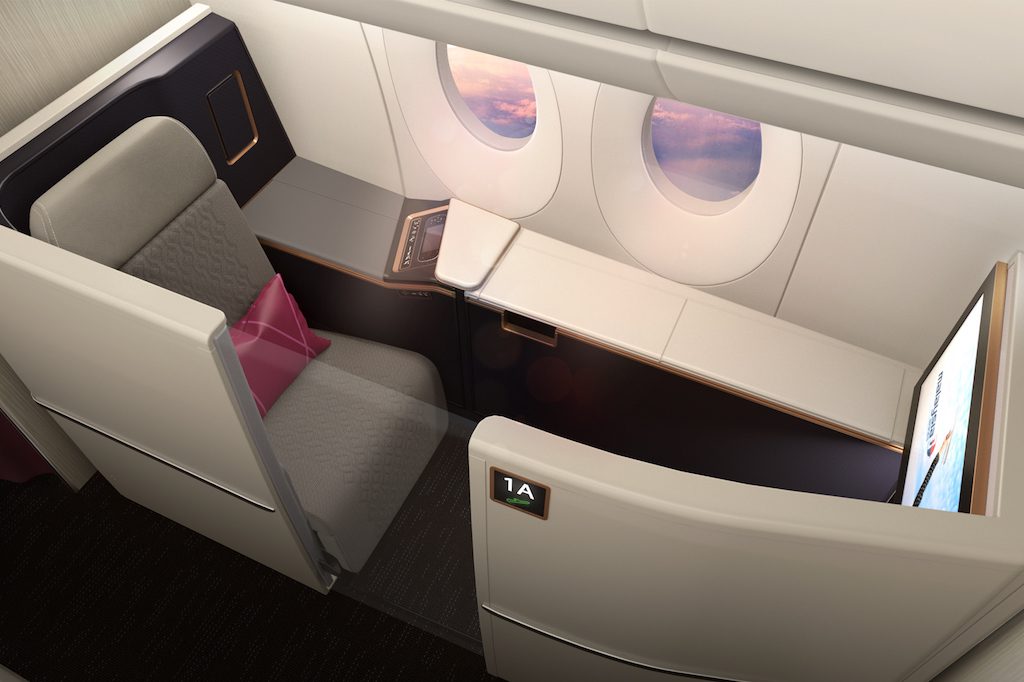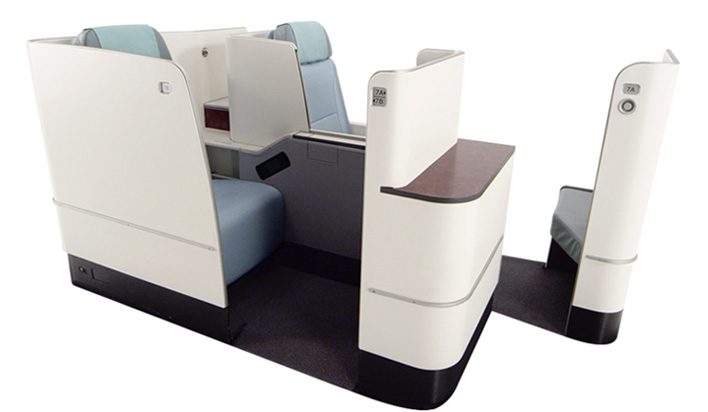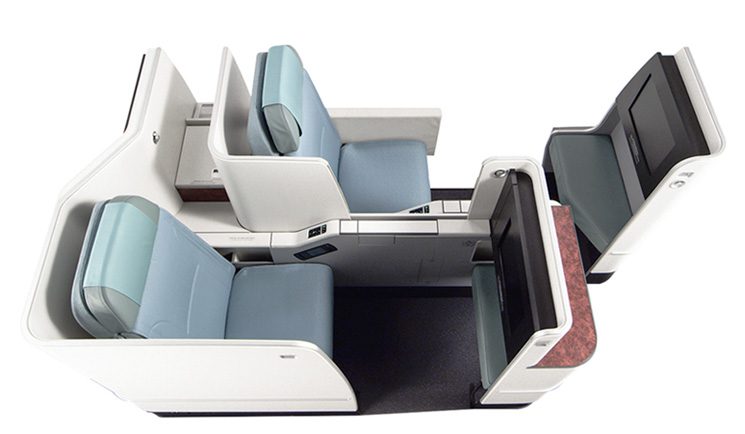Skift Take
Asian airlines still cling to first class, but is the product necessary anymore? Some carriers are rethinking their strategies.
When Malaysia Airlines added its first Airbus A350-900 about a year ago, Airbus hailed it as the first carrier to install first class on the new jet, outfitting its cabin with four seats, each with privacy doors.
But there was a problem: By global standards, the cabin wasn’t opulent and customers weren’t paying hefty premiums to sit in it. So late last year, Malaysia redefined its marketing, turning what was an average product into a “Business Suite,” with many perks of first class at a lower price. Malaysia also renamed the larger first class suite on its Airbus A380s.
It was an admission that Malaysia didn’t have the product — or the route network — to compete with Asia’s biggest airlines, like Singapore Airlines and Cathay Pacific. These airlines can profitably sell first class on many flights for $10,000 or more, attracting customers by offering gigantic seats, caviar, and Dom Perignon and Krug champagne.
A Newish Trend in Asia
But in not completely squashing its most premium product, Malaysia joined a newish trend in Asia. Rather than go business class-only, like many North American and European airlines do, some Asian carriers have set aside a handful of premium seats for customers willing to pay higher-than-business class prices. Malaysia is betting passengers, including executives and government officials no longer permitted to buy first class, will seek out a more private cabin with more personalized service.
“There are 12-14 major routes around the world where people actually pay for first class in meaningful numbers,” said Samuel Engel, head of the aviation group at ICF, a consulting firm. “If Malaysia is not able to get a meaningful number of customers to pay first class fares for those seats, it does make sense for them to position it in a way where people will pay.”
Other airlines have tried versions of this strategy, often with older products. Carriers may not want to replace outdated first class, so they sell it as business, perhaps offering the better seats to all customers for a fee, or giving them to frequent flyers. But this is slightly different, as Malaysia’s seats are new, and could be around for awhile.
Still, selling the seats at a premium could be a challenge, said Seth Kaplan, editor of Skift Airline Weekly.
“The problem for these airlines with selling something superior to business class is that their own business-class cabins are very nice,” he said. “That’s the competition: The cheaper lie-flat, all-aisle-access seats right behind these super-premium seats. They have to hope a number of other airlines match this move for it to become something widely accepted enough that it can be sold to a lot of business travelers.”
Other Airlines Making Similar Moves
At least three carriers — Malaysia, China Eastern and Korean Air Lines — now sell what is essentially a business class seat as more premium product on some long-haul flights.
With its new Airbus A350s, the first of which was delivered late last year, China Eastern has installed four seats in what it calls a “premium business” cabin. The seats look like business, but the airline is dressing them up with larger television screens, minibars and storage lockers.
China Eastern is positioning them for corporate clients, noting they can use the space for work. Two seats can fold up, the airline said in a release, “allowing flight crew to reshape the space into a community area that up to four people can comfortably use for a business meeting or family gathering.”
It sometimes has been described as first class, but a U.S.-based spokesman confirmed the four seats are “not a true first class cabin and is rather a premium business class product.” The spokesman declined to comment on the strategy. China Eastern’s Boeing 777-300ERs, also used for long-haul routes, retain first class suites.
Korean Air Lines is trying something different. On its new Boeing 787-9s, it has the same seats in first class as in business class, though front cabin passengers have more space and a larger television screen. Still, Korean markets and prices the product as first class, with the same over-the-top service as in Boeing 747 and Airbus A380s suites.
Some reviewers have wondered why — “It’s underwhelming (and lazy) that Korean Air uses a business class seat for their first class cabin,” blogger Ben Schlappig wrote after a flight from Seoul to San Francisco — but the airline stands by it.
John Jackson, a vice president for Korean’s in the Americas, declined to discuss the 787 approach in detail, but said, “first class is not going anywhere” and noted first class customers, including those on the 787, have access to special check-in in Seoul, as well as a personalized meet-and-greet service.
Pushing Segmentation?
For Malaysia, going with a business suite made more sense than keeping first class, said Mark Ross-Smith, who until October was head of the airline’s loyalty program.
Since the market for true first class is so small, he said, most airlines fill cabins with the same customers — high net-worth individuals, passengers who buy discounted around-the-world tickets, and customers traveling on reward tickets. Among them, wealthy travelers are most in demand, but Ross-Smith noted they’re “spoiled for choice,” and prefer best-in-class products from Emirates, Etihad, Cathay Pacific and Singapore.
“For Malaysia, why try and compete at the high end when competition is so fierce?” he said. “Business Plus makes sense because business and government officials are allowed to purchase those fares, and it is no longer in competition, or benchmarked against other first class cabins.”
After renaming the product, but keeping many of the perks — including priority check-in and access to Malaysia’s first class lounge – the carrier can keep fares competitive, an airline spokeswoman said in an email. “We wanted to meet that demand at an attractive price point for our passengers,” she said. “The suite is an enhanced business class experience, with more privacy that comes with first class offerings and perks at a competitive price.”
Malaysia could have called the seats business class and given them free to elite flyers, but with this approach, it can test whether it can create a new customer segment.
That’s probably a worthwhile strategy, Engel said, as the market could be ready for several types of business class. He noted most airlines once had only one type of economy class seat, but now many have three — regular, extra-legroom, and premium.
“The natural evolution of this trend of segmentation should also include new segments above business and below first class,” he said. “If that’s true, Malaysia is actually a pioneer here and we may see other carriers follow.”
But Kaplan said he’s not sure the above-business segment is so big. Corporate travel planners are smart, he said, and they won’t be tricked into booking first class-style products for employees because an airline renames them.
“The tricky thing is to get any unusual product to be accepted in the corporate travel community,” Kaplan said. “I’m a little skeptical that many corporations will allow their employees to pay more than the lowest-available business-class fare on a given flight for something even nicer, whether it’s called ‘first class’ or something else.”
The Daily Newsletter
Our daily coverage of the global travel industry. Written by editors and analysts from across Skift’s brands.
Have a confidential tip for Skift? Get in touch
Tags: airbus, airline innovation, airline passenger experience, cathay pacific, korean air, lufthansa, malaysia air
Photo credit: A UK consultancy called factorydesign created a new first class cabin for Malaysia Air. The cabin is now being sold as premium business class. factorydesign


